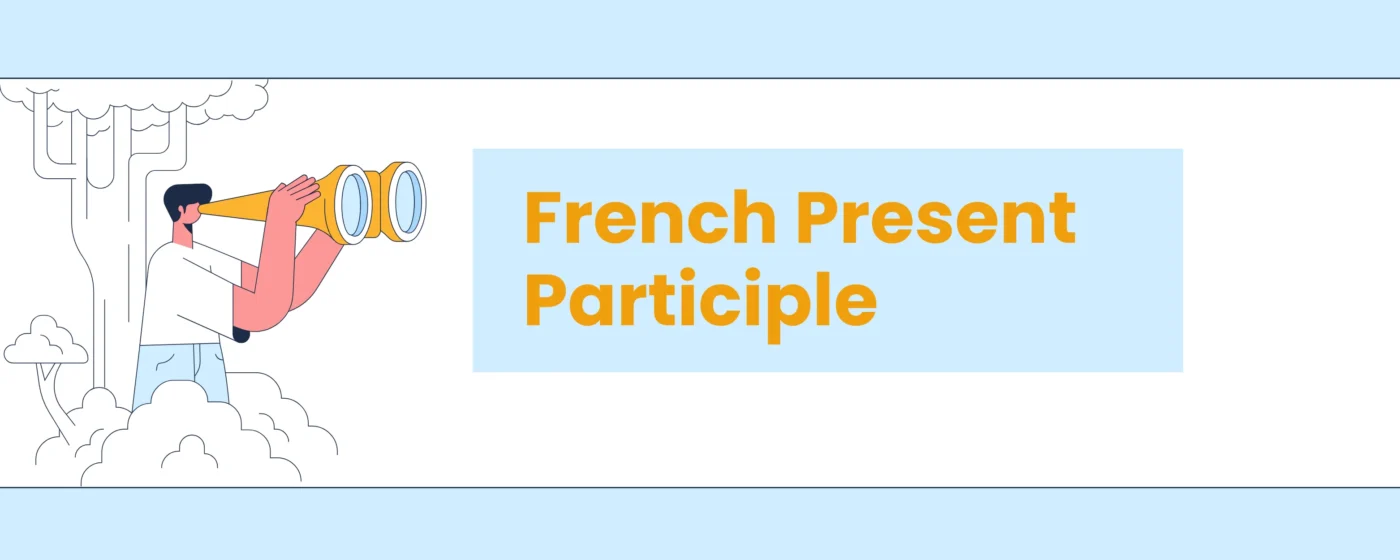The French present participle is a dynamic tool for sentence construction and enhancement. It injects fluidity, enabling concise and elegant expression. By mastering its usage, you’ll improve both your written and spoken French, achieving greater sophistication with ease. Are you ready for this aventure? Allez-y!
Key Takeaways
- Learn the rules and usage of the present participle in the French language and understand in detail where and how you can use this tense in sentences.
- Learn the Form of the present participle, it’s easy in nous present tense minus -ons + -ant (parlons → parlant); irregulars like étant (being), ayant (having).
- Teach in depth the uses of simultaneous actions (Elle chante en travaillant), adjectives (histoire captivante), or replace relative clauses (étudiants parlant français).
- Make sure you are avoiding traps, such as no “J’aime lisant” (say J’aime lire), don’t agree as adjective (chantant, not chantante), keep close to the noun.
- Know the master tips of present participle, like memorise formation, read or listen actively, use relatives if stuck, practice context over rules.
What is the French Present Participle?
The French present participle is called the participe présent. It is formed by adding “-ant” to the verb stem. Simply put, it’s the French equivalent of the English verb form ending in “-ing”.
How to Form the Present Participle in French?
To form the French participe présent, we take the nous form of the present tense verb, remove the “-ons”, and add “-ant” ending.
Examples:
Parler (to speak): nous parlons → parl-ant (speaking)
Finir (to finish): nous finissons → finiss-ant (finishing)
Prendre (to take): nous prenons → pren-ant (taking)
While most French present participles follow the regular “-ant” ending, a few key verbs have irregular forms. Here are some examples of irregular present participles.
| Infinitive | Present Participle |
|---|---|
| être (to be) | étant (being) |
| avoir (to have) | ayant (having) |
| savoir (to know) | sachant (knowing) |
Uses of the Present Participle in French
The participe présent in French is versatile and has several uses:
1. To describe simultaneous actions (le Gérondif): The present participle in French can be used to convey actions happening at the same time.
Example: Elle chante en travaillant. (She sings while working.)
Here, “travaillant” indicates an action occurring simultaneously with “chante”.
2. As an adjective: The present participle in French can also function as an adjective, describing a noun.
Example: C’est une histoire captivante. (This is a captivating story.)
Here, “captivante” describes “histoire”.
3. In place of a relative clause: Lastly, the present participle in French can replace relative clauses, making sentences more concise.
Example: Les étudiants parlant français. (The students speaking French.)
This is a shorter way of saying “Les étudiants qui parlent français.” (The students who speak French.)
Struggling with French past tense? This detailed guide on the Passé Composé breaks down usage and examples clearly for learners.
Difference Between Present Participle and Gerund
It’s important to understand the distinction between the French present participle and the gerund, as they serve different grammatical functions. Let’s explore this distinction:
| Feature | Present Participle | Gerund |
|---|---|---|
| Formation | Verb stem + -ant | “en” + Verb stem + -ant |
| Function | Works as an adjective, a descriptor of simultaneous action description or to convey relative clause replacement | Expresses manner and simultaneous action (useful for expressions with “while” or “by”) |
| Focus | Describes a state or simultaneous action | Emphasizes the manner or cause of an action |
| Example | J’ai vu l’homme marchant dans la rue. (I saw the man walking in the street.) Here, “marchant” (walking) acts as an adjective describing the “homme” (man). | J’ai vu l’homme en marchant dans la rue. (I saw the man while walking in the street.) Here, “en marchant” (while walking) modifies the action of “ai vu” (saw). |
Grammar Made Easy as Bonjour!
Our tutors guide you through tricky grammar points to make French a breeze.
5 Common Mistakes to Avoid
When working with the French participe présent, it’s easy to fall into some common traps, especially for English speakers. Here are 5 key mistakes to avoid when you use participe présent in French:
- In English, you might say “I like reading”. However, in French, you cannot say “J’aime lisant”. Instead, you can say “J’aime lire” or “J’aime la lecture”
- Failing to understand the difference between the present participle and the gerund can be a problem. You must remember that the gerund is always preceded by “en” and modifies a verb. However, the present participle modifies a noun. For example, “Nous avons vu les gens courant” is the present participle form, while “Nous avons vu les gens en courant.” is the gerund form.
- Unlike adjectives, the participe présent does not agree in gender or number with the noun it modifies.
Don’t say: “les filles chantantes”
Say: “les filles chantant” - French tends to avoid overusing the participe présent, especially in casual or spoken contexts. Often, it’s more natural to use a relative clause.
Don’t say: “Les étudiants préparant l’examen…” (can sound too formal or literary)
Say: “Les étudiants qui préparent l’examen…” is more natural. - In French, word order matters. If the participle is too far from the noun it modifies, the meaning becomes unclear.
Don’t say: “Le chien a couru dans le jardin, aboyant.”
Say: “Le chien aboyant a couru dans le jardin.” (The barking dog ran in the garden.)
Strengthen your language skills by exploring essential topics in A Comprehensive Guide to Core French Grammar for clearer understanding.
5 Tips to Master Le Participe Présent
Here are 5 concise, actionable tips to master French present participles:
- Memorize the Formation: Start with the “nous” form of the present tense, drop “-ons”, and add “-ant”. Practice this regularly.
- Practice Agreement: When used as an adjective, ensure the present participle agrees in gender and number with the noun. Create flashcards with examples.
- Read and Listen Actively: Pay close attention to how present participles are used in authentic French materials (books, films, podcasts).
- Use Relative Clauses as Alternatives: If unsure, use “qui + verb” (relative clause). This is often more natural in spoken French and provides a safety net.
- Focus on Context: Don’t just memorize rules. Understand why a participe présent is used in a specific sentence. Does it describe a simultaneous action, a characteristic, or something else? Context is key!
Did You Know?
- Although the participe présent exists in French, French uses the infinitive far more often where English uses “-ing” verbs.For example: Swimming is fun.
- The present participle can be used as an adjective, in which case it agrees in gender and number.For example: un enfant charmant (a charming child)
Conclusion
The French participe présent is a subtle yet important tool to unlocking your French nuance. Embracing it will help deepen your language, and add a certain “je ne sais quoi”. For you to successfully cover this journey of French present participles, we have created this guide full of linguistic secrets. However, if you feel that’s not enough for you, enrol today at La Forêt French Class or explore our plethora of resources by visiting Language Learning Blog.
Frequently Asked Questions
1. Give 5 examples of participe présent in French.
- Les oiseaux chantant dans les arbres égayaient la matinée.
(The birds singing in the trees brightened the morning.)
“Chantant” describes the birds.
- Une vague déferlante a inondé la plage, surprenant les baigneurs.
(A breaking wave flooded the beach, surprising the swimmers.)
“Déferlante” describes the wave.
- J’ai vu une femme pleurant sur un banc du parc.
(I saw a woman crying on a park bench.)
“Pleurant” describes the woman.
- Les feuilles tombant des arbres recouvraient le sol.
(The leaves falling from the trees covered the ground.)
“Tombant” describes the leaves.
- Un homme portant un chapeau rouge traversait la rue.
(A man wearing a red hat was crossing the street.)
“Portant” describes the man.
2. How do I avoid confusing the present participle with the gerund?
The key difference is the presence of “en”. The gerund is always preceded by “en” and modifies a verb, indicating how or when an action is performed. The present participle stands alone and modifies a noun, acting like an adjective.





